
There has been plenty abuzz about Samsung and Google’s latest and greatest, the Galaxy Nexus, but one thing we haven’t heard talked about much is the display. Yes it is amazingly gorgeous coming in at 4.65″ and having a large 1280 x 720p resolution, but we’ve had many questions and comments asking about the panel type. Yes the Samsung Galaxy Nexus uses a Pentile Matrix display but don’t worry it still looks great. What is the difference between RGB and PenTile you ask? All the details are after the break.
How this works is the way the pixels are displayed on the screen. For an example the original Galaxy S used the Super AMOLED display and while it looked awesome, used a PenTile display where each sub-pixel shares colors instead of getting their very own. This not only makes the display a little on the fuzzy side but it also gives the screen that blue hue, as well as the color green being a little underwhelming. The Galaxy S II however, uses the newer Super AMOLED Plus from Samsung and the “Plus” is Samsung’s way of saying they are using a full RGB color display instead of the cheaper PenTile that shares colors and pixels. The image below is a perfect example of this:

The device might be old but this same situation was a big deal when the original Google Nexus One was released and you can see those images by clicking here. No Samsung didn’t forget to add the “Plus” to the new Galaxy Nexus rocking Ice Cream Sandwich, in order to achieve that high 1280 x 720 resolution and keep the awesome colors and contrast of an AMOLED panel they had to compromise a bit. So why does this matter? Using the PenTile in real world scenarios for users will result in slightly less detail and a loss of sharpness, not to mention the color hue we talked about earlier.
Is this a bad thing or a game changer? I don’t think so. For those with eagle eye vision they may be able to spot the differences, but one thing the Galaxy Nexus has going for it is the higher resolution. The 1280 x 720 resolution offers a much higher pixel density close to that of the iPhone’s “Retina” display. So all the pixels are that much smaller and crisper, so while we do have a PenTile display on board the screen should still look gorgeous. The cons of the PenTile will be much less noticeable on the higher resolution the Galaxy Nexus comes with compared to, say, the original Galaxy S that sports a 800 x 480 resolution.
Obviously I would’ve loved to see the Galaxy Nexus come with a Super AMOLED Plus full RGB display and the high resolution, because anyone would, but I’m perfectly fine with the PenTile for now and will gladly pick up the Nexus come launch day. In case you missed any of our coverage of the new superphone feel free to check out our Galaxy Nexus and Ice Cream Sandwich portals just linked to, then watch our hands-on videos seen below and decide for yourself if the screen is beautiful or not.
Galaxy Nexus hands-on
[vms 55018e2a459517fdb40e]
Ice Cream Sandwich hands-on
[vms 4b1be110b7bf70c8362d]
[device id=1740]
[via FlatPanelsHD]










The source seems to leave out the 16:9 wide screen and 100,000 : 1 contrast ratio capability. Just saying.
truth